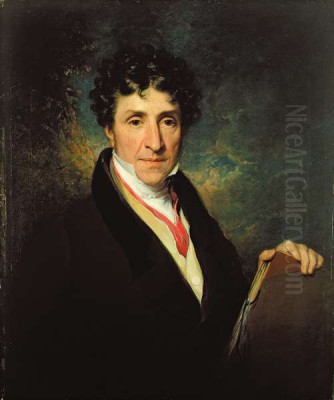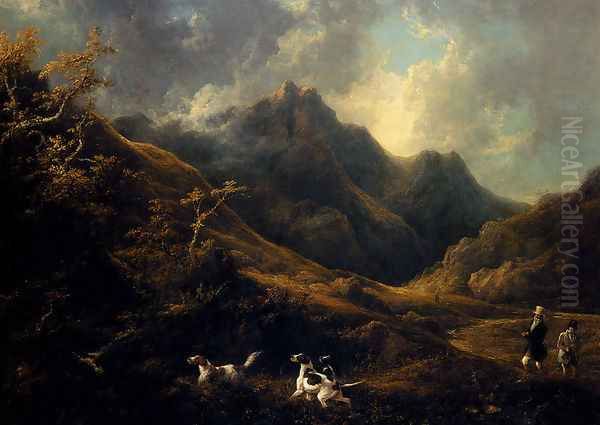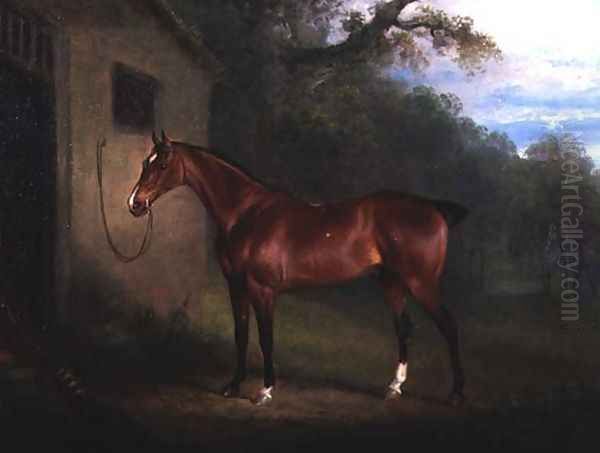
Charles Henry Schwanfelder stands as an intriguing figure in the annals of British art, a painter of German origin who carved a niche for himself primarily in the north of England during the late 18th and early 19th centuries. Born in 1774 and passing away in 1837, his life spanned a period of significant artistic and social transformation. While perhaps not as universally acclaimed as some of his towering contemporaries, Schwanfelder's contributions, particularly in animal painting and portraiture, offer a valuable insight into the regional artistic currents and patronage systems of his time.
Early Life and Artistic Foundations
Charles Henry Schwanfelder's story begins not in the bustling art centers of London, but in Germany. He was born into an artistic household, the son of a decorative painter. This familial background undoubtedly provided his earliest exposure to the arts and crafts. In these formative years, young Schwanfelder was not merely an observer but an active participant, assisting his father in the meticulous work of painting decorative motifs on items such as clock faces and snuff boxes. This early training, though perhaps more craft-oriented than academic, would have instilled in him a keen eye for detail, a steady hand, and a practical understanding of pigments and application techniques.
Such an apprenticeship in decorative arts was not uncommon for artists of that period. Many painters who later achieved fame in "higher" forms of art, like easel painting, often began their careers in more utilitarian or decorative fields. This grounding could provide a solid technical foundation, emphasizing precision and finish, qualities that could then be translated into more ambitious artistic endeavors. The skills honed in painting intricate designs on small, complex surfaces like snuff boxes would have demanded considerable dexterity and control.
Relocation to England and the Leeds Connection

At some point, Schwanfelder made the significant move from Germany to England, eventually settling in Leeds, Yorkshire. This relocation marked a pivotal chapter in his life and career. Leeds, during the late 18th and early 19th centuries, was a rapidly growing industrial town, benefiting from the burgeoning wool trade and the broader Industrial Revolution. This economic expansion created a new class of affluent individuals – merchants, industrialists, and professionals – who became patrons of the arts, seeking portraits, landscapes, and other works to adorn their homes and signify their status.
It was in this environment that Schwanfelder established himself. He became known, notably, as an animal painter to distinguished families in the Leeds area, a role that suggests a certain level of local renown and trust from patrons who valued their livestock, hunting dogs, and horses. The phrase "animal painter to the Royal Family in Leeds," as sometimes mentioned, likely refers to prominent local families with significant standing, rather than an official appointment from the British Crown itself, though connections to gentry or even minor nobility in the region are plausible.
Beyond his artistic pursuits, Schwanfelder demonstrated a commitment to his adopted community by becoming a member of the Leeds 289th Loyal Independent Volunteers. This involvement in a local militia, particularly during the Napoleonic Wars when such volunteer corps were vital for national defense, indicates a degree of integration into local society and a sense of civic duty.
Artistic Style and Thematic Focus
Schwanfelder's primary medium was oil painting, and his oeuvre encompassed several genres, most notably animal painting, portraiture, and landscapes, often intertwined. His style, as gleaned from available descriptions and surviving works, was characterized by careful observation, fine brushwork, and an ability to capture the character of his subjects, whether animal or human.
In an era that saw the tail-end of the Rococo's lightness and the burgeoning force of Romanticism, Schwanfelder's work likely balanced traditional representational skills with an emerging sensitivity to individual character and naturalistic detail. His early decorative work might have imbued his painting with a certain refinement and attention to surface, while his engagement with living subjects – animals and people – would have pushed him towards capturing vitality and personality.
The description of his portraiture as exhibiting "fine brushwork" and "profound character depiction," leading to a "true and powerful expression of individual traits," suggests an artist who aimed beyond mere likeness. He sought to convey something of the inner life or distinctive nature of his sitters, a hallmark of successful portraiture in any period. This aligns with the growing emphasis on individualism that characterized the Romantic era.
Representative Works: Glimpses into His Art

Among Schwanfelder's known works, "Shooting in the Highlands" and his portrait of "Richard Elliott" are frequently cited as representative pieces. These titles alone offer clues to his artistic interests and the types of commissions he undertook.
"Shooting in the Highlands" immediately evokes the popular genre of sporting art, which had a long and distinguished tradition in Britain. Artists like George Stubbs and Sawrey Gilpin had elevated animal and sporting painting to a high art form in the preceding decades. Schwanfelder's painting would likely have depicted a scene of gentlemen engaged in hunting amidst the dramatic landscapes of the Scottish Highlands. Such works appealed to a clientele interested in field sports and the picturesque, rugged scenery that was becoming increasingly fashionable, partly due to the writings of Sir Walter Scott and the general Romantic fascination with wild, untamed nature. The painting would have required skill in rendering animals (likely dogs and game birds), human figures in action, and the atmospheric qualities of the landscape.
The portrait of "Richard Elliott" points to Schwanfelder's activity as a portraitist. The fact that this work was later acquired by the Leeds City Art Collections Fund underscores its perceived local historical and artistic value. Portraits of local dignitaries, merchants, and professionals were a staple for regional artists. Such commissions provided a steady income and allowed painters to showcase their skills in capturing likeness and character. Without viewing the specific work, one can surmise it would aim to present Elliott with dignity and individuality, reflecting his social standing and personality as perceived by the artist and desired by the sitter.
Another interesting facet of his output includes designs such as the "Fidelity R.A. Chapter Apron," indicating his involvement in creating emblematic or ceremonial art, possibly for Masonic or other fraternal organizations. This links back to his roots in decorative arts and showcases a versatility beyond standard easel painting.
The Broader Artistic Context: Britain in Schwanfelder's Time
To fully appreciate Schwanfelder's career, it's essential to place him within the vibrant and evolving British art scene of his time. The period from the 1770s to the 1830s was transformative. The Royal Academy of Arts, founded in 1768 with Sir Joshua Reynolds as its first president, had become the dominant institution, shaping artistic taste and providing a crucial platform for exhibition and recognition.
Portraiture remained a highly lucrative and prestigious genre. Reynolds himself, along with Thomas Gainsborough, George Romney, and later Sir Thomas Lawrence and Sir Henry Raeburn, created iconic images of the era's elite. These artists set a high bar, and while Schwanfelder operated primarily in a provincial context, the influence of these London-based masters would have been pervasive through exhibitions and widely circulated prints.
Landscape painting was undergoing a revolution, moving from topographical records and idealized Claudian scenes to more naturalistic and emotionally charged expressions. Gainsborough had already shown a profound love for landscape. The period saw the rise of J.M.W. Turner and John Constable, who would redefine the genre and elevate British landscape painting to international prominence. While Schwanfelder's landscapes might have been more conventional, the growing appreciation for nature would have created a market for such works.
Animal painting, Schwanfelder's specialty, also flourished. George Stubbs had brought an unprecedented level of anatomical accuracy and dignity to the portrayal of horses and other animals. Sawrey Gilpin was renowned for his spirited depictions of horses, often in dramatic or pastoral settings. George Morland captured rustic scenes with animals, appealing to a taste for the picturesque and sentimental. Later in Schwanfelder's career, Edwin Landseer would emerge as a dominant force, known for his technical brilliance and often anthropomorphic portrayals of animals, which resonated deeply with Victorian sensibilities. Schwanfelder's work would have been part of this rich tradition, catering to patrons who admired the beauty, utility, or symbolic power of animals.
The influence of Romanticism was also keenly felt, encouraging artists to explore themes of emotion, individualism, the sublime power of nature, and historical or exotic subjects. Artists like Henry Fuseli and William Blake pushed the boundaries of imagination, while others incorporated Romantic sensibilities into more traditional genres.
Schwanfelder in the Realm of Animal Painting
As an animal painter, Charles Henry Schwanfelder contributed to a genre that held particular appeal for the British gentry and agricultural society. His depictions would have ranged from prized livestock, reflecting agricultural prosperity, to sporting dogs and horses, integral to the leisure pursuits of his patrons.
Compared to the scientific rigor of George Stubbs, who famously dissected horses to understand their anatomy, Schwanfelder's approach may have been more focused on capturing the living essence and characteristic appearance of the animals he painted. His work likely shared common ground with artists like James Ward, who also painted powerful animal subjects and rural scenes, or perhaps the more direct, less sentimental style of earlier animal painters before the rise of Landseer's narrative-driven compositions.
The demand for animal portraits was steady. Landowners wanted records of their prize bulls or sheep; sportsmen commissioned paintings of their favorite hunters or hounds. Schwanfelder, by establishing himself as an animal painter in Leeds, tapped into this consistent market. His German training in detailed decorative work might have lent itself well to the careful rendering of fur, feather, and musculature required for convincing animal portraiture.
Schwanfelder as a Portraitist
In the field of portraiture, Schwanfelder would have faced the towering reputations of London's leading artists, but the demand for portraits extended far beyond the capital. Provincial painters played a crucial role in satisfying the needs of local clientele. His portrait of Richard Elliott is a testament to this aspect of his career.
His style, described as conveying "character" and "individual traits," suggests he was aligned with the broader trends in portraiture that moved beyond mere formal representation. Artists like Joseph Wright of Derby, a contemporary who famously painted Schwanfelder's own portrait, exemplified how a painter based outside London could achieve significant artistic success and develop a distinctive style, often catering to the emerging industrial and scientific figures of the provinces. Schwanfelder, in Leeds, would have had a similar opportunity to document the faces of a society undergoing rapid change.
His portraits would likely have been less about the "Grand Manner" promoted by Sir Joshua Reynolds, which often involved classical allusions and idealized representations, and more about a direct, perhaps more intimate, portrayal of the sitter. The emphasis on "fine brushwork" suggests a careful, polished technique, appealing to patrons who valued craftsmanship and a clear, recognizable likeness. He would have competed with other itinerant or locally established portraitists, and his success would have depended on his ability to deliver satisfactory likenesses that also possessed a degree of artistic merit.
The Leeds Connection and Local Significance Revisited
Schwanfelder's decision to base himself in Leeds rather than London is significant. While London was the undeniable center of the British art world, offering the greatest opportunities for fame and fortune, provincial cities and towns supported their own artistic ecosystems. Leeds, with its growing wealth, provided a viable market for an artist with Schwanfelder's skills.
His membership in the Leeds 289th Loyal Independent Volunteers further cemented his local ties. Such volunteer regiments were a common feature of British life during the Napoleonic era, fostering a sense of local pride and patriotism. His participation suggests he was not an isolated émigré but an integrated member of the Leeds community. This local standing would have been beneficial for securing commissions, as patronage often relied on personal connections and reputation within a specific social network.
The artistic life in cities like Leeds, Manchester, Liverpool, or Bristol during this period is an important area of study. These urban centers were developing their own cultural institutions, and artists like Schwanfelder contributed to this cultural enrichment. His work would have been seen in local homes, perhaps in local exhibitions if any were organized, and would have formed part of the visual culture of the region.
Legacy and Historical Assessment
Charles Henry Schwanfelder's legacy is primarily that of a competent and respected regional artist who made a tangible contribution to the artistic life of Yorkshire, particularly Leeds. He may not have revolutionized any particular genre or achieved the widespread fame of a Turner, Constable, or Landseer, but his work holds value for several reasons.
Firstly, he represents the many skilled artists who worked outside the major metropolitan centers, providing essential artistic services to their communities. The study of such artists offers a more complete and nuanced understanding of art history, moving beyond a sole focus on the "great masters."
Secondly, his specialization in animal painting places him within an important British artistic tradition. His works in this genre, alongside his portraits and landscapes, reflect the tastes and interests of his patrons – the gentry, industrialists, and professionals of a thriving northern English town.
Thirdly, his German origins and early training in decorative arts add an interesting dimension to his profile as a British painter. This background may have informed his technique and aesthetic sensibilities in subtle ways. The portrait of him by Joseph Wright of Derby also provides a fascinating link between two significant provincial artists of the period, suggesting a degree of collegiality or mutual respect within the artistic community outside London.
While detailed information about his life and a comprehensive catalogue of his works may be less abundant than for more famous figures, Charles Henry Schwanfelder remains a noteworthy artist. His paintings, such as "Shooting in the Highlands" and the portrait of Richard Elliott, serve as tangible reminders of his talent and his role in the cultural fabric of early 19th-century Britain. His career underscores the fact that artistic activity was vibrant and varied across the country, not just confined to the capital.
Conclusion: A Painter of His Time and Place
Charles Henry Schwanfelder (1774-1837) navigated the British art world with a skill set honed from his early experiences in Germany and adapted to the demands of his adopted home in Leeds. As an oil painter specializing in animals and portraits, he catered to a regional clientele, capturing the likenesses of local figures and the prized animals and sporting scenes beloved by the gentry. His work, viewed within the context of contemporaries like George Stubbs in animal art, or the great portraitists such as Reynolds and Gainsborough, and even fellow provincial artists like Joseph Wright of Derby, finds its place as a sincere and capable contribution.
He may not have been an innovator on the scale of Turner or Constable, nor achieved the popular acclaim of Landseer, but Schwanfelder's career is a testament to the enduring importance of skilled artists serving their communities. His paintings offer a window into the society, tastes, and artistic patronage of northern England during a dynamic period of British history. By remembering and studying artists like Charles Henry Schwanfelder, we gain a richer, more textured understanding of the broad landscape of art history.